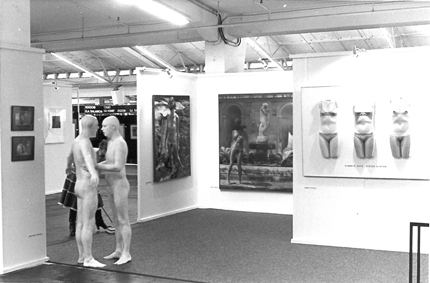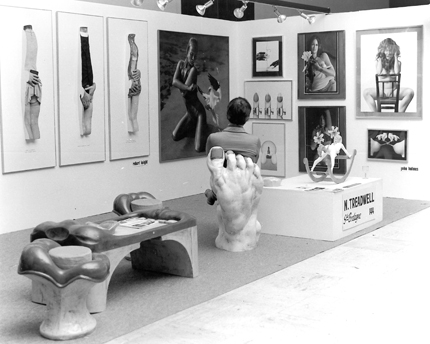A Summary of the Treadwell Gallery`s Previous Locations.
Starting out with Mobile Galleries (A double decker bus and furniture removal vans) with the aim of taking art to the people in the early sixties (1963), the Treadwell Gallery opened in Chiltern Street, London W1 in 1968. The Chiltern Street Gallery was unique in concentrating on Art about the human condition at a time of mainly hard edge abstract and minimalism within the current art scene. It was a time of vast social change in the real world, and the Nicholas Treadwell Gallery reflected it. Galleries and the Art World in general were forbidding, frequently obscure and invariably pretentious. The Treadwell Gallery with it`s down-to-earth and provocative style soon developed a controversial and sensationalist reputation. In 1971, reviewing an exhibition, the magazine, Art and Artist wrote about the gallery… ‘ the place blisters with works of searing eroticism, high camp, coarse belly laughs and hideous vulgarity… all ingredients in the best surrealist tradition…`
The gallery at 36, Chiltern Street can be seen to have had a catalysing effect in bringing together some of the misfits, eccentrics and bloody-minded individuals who were a new breed of artists emerging from British art schools during the latter part of the sixties and the seventies. In 1978, Nicholas Treadwell acquired Denne Hill, an impressive Victorian Mansion near Dover, which till 1984 he ran in conjunction with the London Gallery.Denne Hill gave substance and power to the modest, though intriguing, London Gallery. The fifty two roomed, sixteen bedroom mansion gave opportunity for the development of a Live Art program, allowed space for the ever increasing Gallery Collection, studios for artists, accommodation for weekend visiting collectors and/or Artists, a meeting place for Artists related to the Gallery, as well as being convenient for Europe (Dover 14 kms), where 60% of the Gallery’s sales now were.
 Cologne Art Fair 1977, with works by Malcolm Poynter, Mike Gorman and Robert Knight.
Cologne Art Fair 1977, with works by Malcolm Poynter, Mike Gorman and Robert Knight.
The early Eighties saw a series of national and international exhibitions of Superhumanism throughout Britain, in Germany, Sweden and in New York, to coincide with the publication of the two Superhumanism Books.
In the late eighties (1987), Treadwell moved his Gallery again to a 3,000 square metre former wool mill in the centre of the northern British city of Bradford. Apart from space for the Gallery and a permanent collection, the restored building, Treadwell’s Art Mill, had built in Cafe, Bar, cinema, theatre and 14 Artists Studios.
With the aim of moving to central Europe, in 1999 Bethnal Green, London became the gallery’s final UK home.
In January 2000, The Treadwell Gallery moved to an idyllic new setting, close to the Bohemian Woods in Upper Austria. Die Station is a collection of buildings with an extensive garden/courtyard, having river frontage on one side and a railway line coming into the property on the other side.
In January, 2005, Nicholas Treadwell moved his Collection and Gallery to the impressive Courthouse and Prison Buildings in the delightful Mühlviertel village of Aigen, just a few Kilometres from the Czech and German borders and directly adjoining the Bohemian Woods.The Courthouse and Prison, having their association with Society`s values of Right and Wrong or Good and Evil are particularly appropriate to house Treadwells Unique Collection of Humanist Art.
